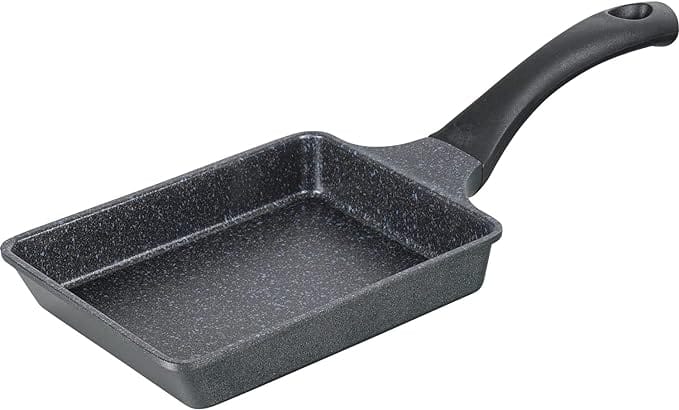Essential for Japanese Cuisine! What is Dashimaki-tamago?
When people think of Japanese cuisine, many imagine "sushi" or "set meals." Among these, there's a dish that's familiar to Japanese people and indispensable to Japanese cuisine. It's "Dashimaki-tamago," or rolled egg made with eggs and dashi broth. Japanese people often eat Dashimaki-tamago for breakfast or as a side dish. When I eat Dashimaki-tamago, it reminds me of the ones made by my mother and grandmother, evoking a sense of nostalgia.
"Dashi" is a broth made by extracting umami components from seafood, seaweed, or shiitake mushrooms through cold or hot water extraction. Typically, it's made using bonito flakes, kombu kelp, dried sardines, or shiitake mushrooms. This "dashi" is not only used in Dashimaki-tamago but is also the source of deliciousness in Japanese cuisine.
Dashimaki-tamago, made by rolling eggs mixed with dashi, is fluffy and combines the aroma and umami of dashi with a touch of sweetness, making it a dish you'll want to eat again and again. Unlike omelets or scrambled eggs, many foreigners are impressed by its gentle flavor and texture. When visiting Japan, be sure to try it.

Various Types of Japanese Egg Dishes
Tamagoyaki
"Tamagoyaki'' is made by adding salt, sugar, soy sauce, or other seasonings to well-beaten eggs, then cooking thin layers and rolling them into a cylindrical shape. Unlike omelet or scrambled eggs, it's made using a special rectangular pan called a "tamagoyaki ki" (tamagoyaki pan), rolling the egg as it cooks.
You can also enjoy variations by adding cheese, green onions, boiled spinach, spicy cod roe, or other ingredients to your liking. It's an essential item in bento boxes. The colors and varied ingredients in bento boxes make it enjoyable to eat every day for lunch, which is why I always include it in my bento. Since it requires a special pan, it takes some practice to make it well.
Atsuyaki Tamago
This dish is prepared using the same method as tamagoyaki but made thicker. Because it contains soy sauce, it develops a distinct grilled appearance.
The seasoning varies by household, and versions with more soy sauce make for a great side dish with rice. It's delicious on its own and perfect for bento boxes, like tamagoyaki. It also makes a great appetizer when eaten with grated daikon radish and soy sauce. You can also cut it into bite-sized pieces for use in sushi rolls or hand-rolled sushi. When I want to eat it with sushi or hand-rolled sushi, I make Thick-baked-tamago.
Dashimaki-tamago
"Dashimaki-tamago" is a type of rolled egg made by mixing well-beaten eggs with dashi broth. This fluffy, flavorful rolled egg is recommended as a side dish or appetizer. Dashimaki-tamago is also delicious when eaten with grated daikon radish and soy sauce.
There are regional differences in taste. In the Kanto region around Tokyo, it's often made with bonito dashi, dark soy sauce, and sugar, resulting in a sweet and rich, clean taste. In the Kansai region around Osaka, it's often made with kombu dashi and light soy sauce, using mirin (sweet rice wine) instead of sugar for a gentler sweetness.
Enjoying these regional differences is part of its charm. I personally love Dashimaki-tamago with a strong dashi flavor. When you try it, you'll likely be impressed by this new delicious aspect of Japanese cuisine.
What You Need for Dashimaki-tamago
Would you like to try making Dashimaki-tamago, an essential part of Japanese meals for breakfast or as an appetizer? While it requires some practice, you can easily enjoy this new egg dish with the delicious flavor of dashi. First, let me introduce the ingredients and tools you'll need.
Ingredients
The ingredients are as follows:
- 4 eggs (medium size)
- Salad oil, as needed
- 4 tablespoons dashi broth
- 2 teaspoons soy sauce
- 1/2 tablespoon sugar
- 1/2 tablespoon mirin
The method of making dashi varies by region. Traditionally, dashi is made by simmering bonito flakes or kombu kelp and then straining.
However, recent methods for making dashi without much effort have become popular. My recommendation is to use "dashi granules" available at supermarkets. You can easily make dashi broth by dissolving them in hot water. There are also tea bag-like dashi packs that you can steep in hot water to make dashi broth. I use these when making Japanese dishes like tamagoyaki, miso soup, or nikujaga (meat and potato stew).
Square Frying Pan
source:Amazon
When making tamagoyaki, you use a square frying pan called a "tamagoyaki ki." Note that you can't make it in a regular round frying pan. You can buy these at Japanese supermarkets or online shopping sites.
Also, use long cooking chopsticks called "Saibashi." Using long chopsticks allows you to keep your distance from the heat source, making cooking easier.
How to Make Dashimaki-tamago
Step 1: Prepare the Egg Mixture
First, make the egg mixture. Crack the eggs into a bowl and mix with Saibashi. Don't whisk in a circular motion. The key is to move the Saibashi back and forth to mix without creating bubbles. If you whisk it like you're beating cream, air will get in. Air makes it difficult to roll when cooking and prevents a fluffy texture, so be careful.
Next, in a separate bowl or cup, mix the dashi broth, soy sauce, sugar, and mirin well.
Once the seasonings are well mixed, add them to the well-beaten eggs to complete the egg mixture.
It takes extra effort, but if you strain the egg mixture through a sieve (a bowl with a mesh) twice, you'll get an even smoother and more beautiful Dashimaki-tamago. Try this if you have the time.
Step 2: Cook 1/5 of the Egg Mixture
Add about 1 teaspoon of salad oil to the square tamagoyaki pan, spreading it over the entire surface. I recommend using kitchen paper to absorb the oil and spread it with chopsticks over the entire pan. Oiling the pan prevents the egg from sticking, making it easier to roll.
Over medium heat, pour a small amount of the egg mixture and start cooking when you hear a sizzle. The important thing here is to use about 1/5 of the egg mixture. Be careful not to pour all the egg mixture at once. For beginners, it's recommended to start with a smaller amount.
Spread the egg mixture over the entire surface and cook thoroughly. If air bubbles form, pop them with chopsticks.
Step 3: Roll from Back to Front When Cooked
When the egg is half-cooked, roll it from the back of the pan towards you, shaping it as you go. It's okay if the egg isn't completely cooked at this point. Tilting the tamagoyaki pan about 45 degrees makes it easier to roll. If it's difficult to roll with chopsticks, using a rubber spatula or turner can be helpful.
The egg rolls and shapes better when it's still half-cooked. Don't cook it for too long, as the soy sauce, sugar, and mirin can cause it to burn easily. Also, overcooking will make it tough, resulting in a less delicious Dashimaki-tamago. This is one of the trickiest parts of making Dashimaki-tamago. I've learned the right timing through many attempts.
Step 4: Move the Egg to the Back and Pour 1/5 of the Mixture into the Empty Space
Move the shaped rolled egg to the back of the pan. If there's no oil left on the surface of the pan, lightly coat it with about 1 teaspoon of oil. As mentioned earlier, using kitchen paper soaked in oil makes this easier. It's helpful to apply a small amount of oil each time before adding more egg mixture to prevent sticking.
Once the oil is spread evenly, pour another 1/5 of the egg mixture into the empty space. Gently lift the already rolled egg with chopsticks to let some of the new mixture flow underneath. Then, start rolling again when the egg is half-cooked.
Step 5: Repeat Steps 3 and 4
Repeat steps 3 and 4 until you've used all the egg mixture. As you roll more layers, the rolled egg becomes thicker and harder to flip. In this case, using a rubber spatula or turner can be helpful. This process requires practice, but you'll get the hang of it and improve with each attempt.
Step 6: Shape the Rolled Egg
Once the Dashimaki-tamago is cooked, gently press it against the edges of the pan to shape it. Then, remove it from the pan and let it rest on kitchen paper for 3-4 minutes. The key is to let it cool slightly as it's still hot. Wrapping it in a traditional Japanese cooking tool called a "makisu" (bamboo rolling mat) used for making sushi rolls can give it a beautiful pattern. You can find these at 100-yen shops in Japan, so check them out if you have the chance to visit one.
If you don't have a makisu, you can use kitchen paper as a substitute. When cutting, wait a bit for it to cool down, as cutting while it's too hot can cause the edges to crumble.
When serving, you can add grated daikon radish and a drizzle of soy sauce for extra flavor.




